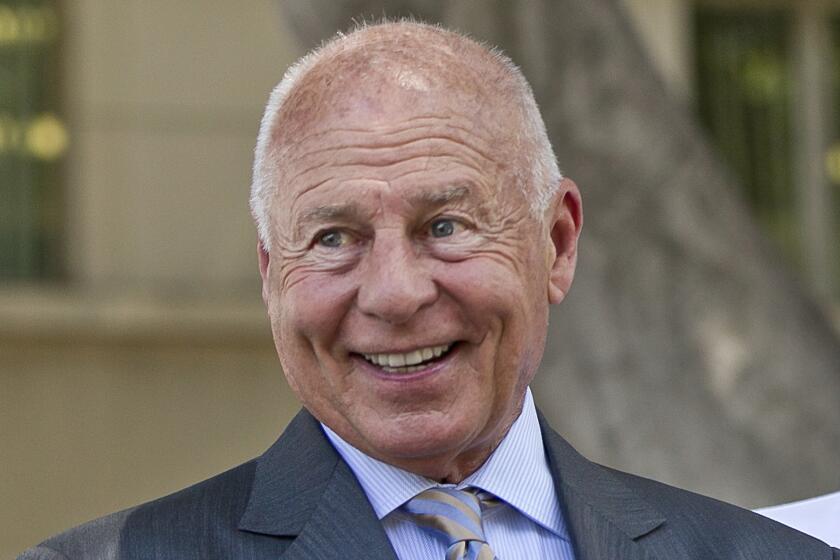Evergreen Cemetery is awash in history, and drowning in blight
- Share via
Laura Mayan attached a crinkle hose to a nearby faucet and dragged it over to the dirt-covered plot at Evergreen Cemetery where her grandmother was buried three years ago. As her mother watched and her daughter frolicked the grounds in a pink Sunday dress, Mayan sprayed water on the sparse weeds sprouting around her grandmother’s grave and another beside it.
It was a hopeless cause. Evergreen Cemetery is green no more.
Once an emerald treasure of Boyle Heights, the expanse of grass and old-world headstones has deteriorated into a wasteland of dead trees, bare dirt and ankle-high shrubs. Its slide from Eastside landmark to neighborhood blight is a tortured saga of broken sprinklers, hapless management, drought and a state agency that has threatened to decertify the cemetery but has limited power to rehabilitate it.
Evergreen’s plight is part of a national crisis of historic cemeteries that have too little space for burials to sustain a healthy cash flow. And while other cemeteries in the state struggle with the drought, the problems at Evergreen run deeper.
Founded in the 1870s, Evergreen became a common ground where waves of diverse immigrants share a final resting place. Jews who populated Boyle Heights in the early 20th century lie there alongside converted Baptist land barons Isaac Lankershim and Isaac Van Nuys, a potter’s field of anonymous Chinese laborers and a section of monuments to the circus performers of a bygone era.
Among the cemetery’s notables is one of L.A.’s most colorful black political pioneers, janitor-turned-City Councilman Gilbert Lindsay. A large section of the grounds is occupied by Japanese Americans who had spilled over from Little Tokyo and moved east to Boyle Heights.
Today, Japanese Americans converge with Latino families paying their respects at family plots. When they arrive, they are confronted with 69 acres of neglect.
The little greenery that remains is largely maintained by families of the recently buried who tend to the graves themselves. They bring sprinklers and string cutters along with folding chairs on their visits to their loved ones’ graves.
Their work maintains a few odd-looking patches of living grass amid the brown earth that forms a prominent half-mile vista between Cesar Chavez Boulevard and 1st Street.
State cemetery officials blame Evergreen’s conditions on its owner, Glenn Wong, who has been under continuous scrutiny for poor practices going back more than a decade.
Wong faced criminal and civil proceedings in 2001 after investigators found bones and pieces of caskets sprinkled atop the grounds of Woodlawn Cemetery in Compton, which he also owned. He was charged administratively with grave desecration, unlawful burial of multiple bodies in a single plot, failure to inter within a reasonable time and failure to keep ownership records. The state also accused him of unlawfully spending the endowment funds of both Woodlawn and Evergreen.
In the criminal case, Wong pleaded no contest to felony conspiracy and two misdemeanors. He was ordered to pay $3,240 in fines and reimburse the Woodlawn endowment fund $96,760. He was placed on two years’ probation and ordered to sell Woodlawn within 270 days.
In 2006, state investigators found more bone fragments — this time in a dirt pile at Evergreen. After being ordered to sift through the dirt, Evergreen eventually turned over 23 bags of bones to the Los Angeles County Coroner. The coroner found the remains of at least five different people among them, and Evergreen was placed on probation.
The Cemetery and Funeral Bureau revoked Evergreen’s operating license in 2010, but a settlement allowed Wong to continue operating during four years of probation.
By the time the probation ended last spring, Evergreen’s grounds had fallen into decay. The Cemetery Bureau again moved to shut down the cemetery for poor maintenance.
In a brief interview at his office, Wong attributed the cemetery’s condition to a litany of problems beyond his control: watering restrictions imposed by the Los Angeles Department of Water and Power, the high cost of water, clay-packed soil, hilly terrain that causes water to run off high spots and headstones that block sprinklers.
“For what we’re doing, for what we have, yes, we’re doing the best we can,” Wong said.
Wong said he is working on a solution with the office of Los Angeles County Supervisor Gloria Molina to transport cheaper recycled water to the cemetery.
State officials dismissed Wong’s contention that the dilapidated irrigation system and watering restrictions imposed by the Department of Water and Power precluded effective maintenance.
In October, Evergreen was again placed on two more years of probation, as the result of another settlement agreement.
In that settlement, the bureau conceded that it might be difficult to maintain the grounds’ during the drought. It ordered Evergreen only to keep “grass and plants as green as seasonably possible in accordance with natural terrain, availability of water, and any established watering restrictions.”
The settlement also acknowledged the limitations of Evergreen’s endowment, funded by a mandatory fee added to each burial. It ordered Wong to notify customers “that the cemetery’s grounds may not be watered on a regular basis due to limitations imposed by” its endowment and drought conditions.
Wong declined to discuss the cemetery’s finances.
According to financial records filed with the state, Evergreen maintains an endowment of about $3 million. State law allows it to spend only a portion of the earnings of that fund each year, however. Last year, Evergreen took about $106,000 in earnings from the endowment, of which $72,802 went to maintenance.
The Cemetery Bureau has no good options, said Christopher A. Brown, a Fresno attorney who represents cemeteries. Because of a quirk in cemetery law, Brown said, cemetery owners are prohibited from spending endowment money on portions of the grounds pre-dating the institution of endowment care fees in the early 1930s.
The state could compel Wong to sell Evergreen. But that could take years, and an aging cemetery with little room for expansion wouldn’t make an attractive investment, experts said. It could also take over the cemetery, but the state is usually reluctant to take on such responsibilities, the experts added.
In the meantime, Evergreen’s heritage continues to rest with those whose loved ones are buried there.
Ana Paz and her husband, Ryne Climaco, spend two to four hours there every Sunday to water the grave of Paz’s mother and several others — as wide as the arc of portable impact sprinkler that Climaco brings.
When she asked the management to tend the grass at her mother’s grave, Paz said she was told the sprinklers were broken.
Paz has developed a connection to the graves around her mother’s. Sometimes she’ll meet the families of the buried and befriend them. She also lets her imagination come up with pictures of the people she never knew, like the 18-year-old man buried nearby and the circus performers in the east part of the lawn.
Paz and Climaco, both 46, said they have come to accept that they can maintain the lot better than the grounds crew will. As residents of Echo Park, where homes rarely come with lawns, they have made taking care of the grave site their gardening.
“It’s peaceful here,” Paz said.
For Mayan, there is less peace and more aggravation when she visits the graveside of her grandmother, Maria Peralta.
She said she wants to move her grandmother’s remains to another cemetery, but doesn’t know if she can afford another burial. She said she does what she can to make up for the lack of maintenance by Evergreen staff.
“They don’t really care about it,” Mayan said of the grounds crew.
After spraying the dirt and some potted flowers for awhile, Mayan rolled up the hose and put it in a yellow pail her mother held. With that, the three generations of Peralta’s descendants walked to their car and drove away.
More to Read
Sign up for Essential California
The most important California stories and recommendations in your inbox every morning.
You may occasionally receive promotional content from the Los Angeles Times.












